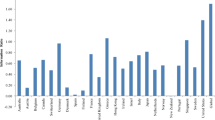Abstract
Employing a hedonic price approach within a framework of central tendencies no conclusive results about the impact of auction houses on final prices of art objects have been found. In order to focus on auction houses as a unit we have applied a benchmarking technique, DEA, developed for efficiency studies. New performance indicators are developed and calculated giving an insight into auction house differences impossible to obtain using hedonic price approach. The performance indicators may also be regarded as quality indicators assuming perfect arbitrage leads to the same unobservable quality of art object obtaining the same price.
Similar content being viewed by others
References
Agnello, R.J. and R.K. Pierce. (2002). “Investment Returns and Risk for Art: Evidence from Auctions of American Paintings.” Eastern Economic Review, 28(4), 443–464.
Andersen, P. and N.C. Petersen. (1993). “A Procedure for Ranking Efficient Units in Data Envelopment Analysis.”Management Science, 39, 1261–1264.
Anderson, R.C. (1974). “Paintings as Investment.” Economic Inquiry, 12, 13–26.
Ashenfelter, O. and K. Graddy. (2003). “Auctions and the Price of Art.” Journal of Economic Literature, 41(3), 763–787.
Banker, R.D., A. Charnes, and W.W. Cooper. (1984). “Some Models for Estimating Technical and Scale Inefficiencies.” Management Science, 30(9), 1078–1092.
Buelens, N. and V. Ginsburgh. (1993). “Revisiting Baumol’s ‘Art as Floating Crap Game’.” European Economic Review, 37, 1351–1371.
Candela, G. and A.E. Scorcu. (1997). “A Price Index for Art Market Auctions. An Application to the Italian Market of Modern and Contemporary Oil Paintings.” Journal of Cultural Economics, 21(3), 175–196.
Chanel, O., L.A. Gérard-Varet, and V. Ginsburgh. (1996). “The Relevance of Hedonic Price Indices.” Journal of Cultural Economics, 20, 1–24.
Charnes, A., W.W. Cooper, and E. Rhodes. (1978). “Measuring the Efficiency of Decision Making Units.” European Journal of Operations Research, 2, 429–444.
Cooper, W.W., L.M. Seiford, and K. Tone. (2000). Data Envelopment Analysis. A Comprehensive Text with Models, Applications, References and DEA-Solver Software. Kluwer Academic Publishers, Boston/Dordrecht/London, pp. 193–197.
Czujack, C. (1997). “Picasso Paintings at Auction, 1963–1994.” Journal of Cultural Economics, 21, 229–247.
Farrell, M.J. (1957). “The Measurement of Productive Efficiency.” Journal of the Royal Statistical Society, Series A, 120 (III), 253–281.
Frey, B.S. and W.W. Pommerehene. (1989). Muses and Markets; Explorations in the Economics of the Arts. Oxford, Basil Blackwell.
Førsund, F.R. (2002). “Categorical Variables in DEA.” International Journal of Business and Economics, 21(1), 31–41.
Førsund, F.R. and R. Zanola (2006). “The Art of Benchmarking: Picasso Prints and Auction House Performance.” Applied Economics (forthcoming).
Locatelli-Biey, M. and R. Zanola. (2002). “The Market for Sculptures: An Adjacent Year Regression Index.” Journal of Cultural Economics.
Pesando, J.E. (1993). “Art as an Investment: The Market for Modern Prints.” American Economic Review, 83, 1075–1089.
Renneboog, L. and T. Van Houtte. (2002). “The Monetary Appreciation of Paintings: From Realism to Magritte.” Cambridge Journal of Economics, 26, 331–358.
Stein, J.P. (1977). “The Monetary Appreciation of Paintings.” Journal of Political Economy, 85, 1021–1035.
Torgersen, A.M., F.R. Førsund, and S.A.C. Kittelsen. (1996). “Slack-Adjusted Efficiency Measures and Ranking of Efficient Units.” Journal of Productivity Analysis, 7(4), 379–398.
Tulkens, H. and P. van den Eeckaut. (1995). “Non-Parametric Efficiency, Progress, and Regress Measures for Panel Data: Methodological Aspects.” European Journal of Operational Research, 80, 474–499.
Author information
Authors and Affiliations
Corresponding author
Additional information
A first version of the paper was written while the first author was a visiting fellow at International Centre for Economic Research (ICER), Turin, January–March 2001. It is part of the project “Cheaper and better?” at the Frisch Centre, financed by the Norwegian Research Council, and of the project on “Cultural goods” financed by the Italian Research Council. We are indebted to Dag Fjeld Edvardsen for help with using the DEA software package of the Frisch Centre.
Rights and permissions
About this article
Cite this article
Førsund, F.R., Zanola, R. DEA meets Picasso: The impact of auction houses on the hammer price. Ann Oper Res 145, 149–165 (2006). https://doi.org/10.1007/s10479-006-0031-x
Published:
Issue Date:
DOI: https://doi.org/10.1007/s10479-006-0031-x




